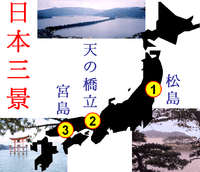Three Views of Japan
The Three Views of Japan (日本三景 Nihon Sankei) is the canonical list of Japan's three most celebrated scenic sights, attributed to 1643 and scholar Hayashi Gahō.[1] The views are of the eponymous pine-clad islands of Matsushima in Miyagi Prefecture; the pine-clad sandbar of Amanohashidate in Kyoto Prefecture; and Itsukushima Shrine in Hiroshima Prefecture. All three are designated Special Places of Scenic Beauty, while Itsukushima is also a Special Historic Site and a UNESCO World Heritage Site.
-
Pine-clad islands of Matsushima
-

Sandbar of Amanohashidate

Coordinates
- Matsushima Bay, Miyagi Prefecture 38°21′59.1″N 141°4′26.6″E / 38.366417°N 141.074056°E
- Amanohashidate, Kyoto Prefecture 35°34′12.4″N 135°11′31.1″E / 35.570111°N 135.191972°E
- Itsukushima (Miyajima), Hiroshima Prefecture 34°17′45.6″N 132°19′11.4″E / 34.296000°N 132.319833°E
New Three Views of Japan
In 1915, modeled on the old Three Views of Japan, Jitsugyo no Nihon Sha (株式会社実業之日本社) held a national election to determine a list of New Three Views of Japan. The New Three Views of Japan are
- Ōnuma (大沼), a big pond in Ōnuma Quasi-National Park, which is at the town Nanae and the east side of Oshima Peninsula in southwest Hokkaidō
- Miho no Matsubara (三保の松原), a pine grove in the Miho Peninsula, in the Shimizu-ku area of Shizuoka
- Yabakei (耶馬渓), a section of river and valley at the upstream and midstream of Yamakuni River (山国川), in Nakatsu, Ōita, Kyūshū
-

Hagoromo no Matsu at Miho no Matsubara
Other lists
Modeled on the traditional list of Three Views of Japan, a large number of other "Three Great X" lists have been devised. Next best known, perhaps, are the Three Famous Gardens (三名園 Sanmeien), namely:
- Kairaku-en, Mito
- Kenroku-en, Kanazawa
- Kōraku-en, Okayama
-

The Kotoji Lantern is emblematic of Kenroku-en
The Three Castles of Japan are
The Three Ancient Onsen are
Or, by another reckoning,
Japan has one hundred famous mountains. It also has sounds, famous waters and other lists.
See also
- List of Special Places of Scenic Beauty, Special Historic Sites and Special Natural Monuments
- 100 Landscapes of Japan (Heisei era)
- 100 Landscapes of Japan (Shōwa era)
- 100 Soundscapes of Japan
- Three Great Gardens of Japan
- Tourism in Japan
- UNESCO World Heritage Sites in Japan
- Three Major Night Views of Japan
- New Three Major Night Views of Japan
References
- ↑ "Amanohashidate - History". Amanohashidate kankokyokai. Retrieved 14 May 2011.
External links
| Wikivoyage has a travel guide for Japan's_Top_3. |
| Three Views of Japan | |
| Amanohashidate – Matsushima – Itsukushima | |
padding-right:0.5em; vertical-align:top" |  – –  | |


